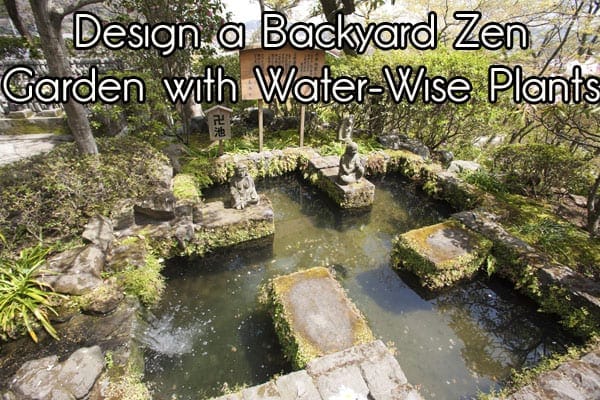Newsletter Articles
Design a Backyard Zen Garden with Water-Wise Plants
Written by Alicia R.
You don’t have to be a devotee of Zen Buddhism to appreciate the calming environment of a Zen garden based on simple yet artful arrangement of gravel, rocks, and plants. It is a place to rest your mind and quietly release stress.
Learning a little bit about Buddhist history helps in understanding the origin of Zen gardens. Buddhism developed in India about 2500 years ago. Some people assert that it is a religion while others maintain that it is a philosophy. Zen meditation — the practice of concentrating on the present moment rather than past or future concerns — is a core practice of Mahayana or “Zen” Buddhism , which is one of Buddhism’s two main branches.
After spreading to China and then to Korea, Zen Buddhism reached Japan during the seventh century. It became popular around 1200, and that’s when Zen’s central idea of stark simplicity began shaping Japanese gardens.
Designing in Traditional Zen Style
Zen garden design is adaptable to different growing conditions. It works for dry gardens in Southern California as well as rain gardens in the Pacific Northwest. Dry gardens are ones based on plants that need little or no supplemental watering once their roots are established. They are drought tolerant. So, don’t be a slave to the idea that you have to duplicate plantings you might find in at a temple in Japan, foggy San Francisco, or rainy Seattle.
Some traditional landscaping elements of Japanese Zen gardens include:
- Muted colors
- Limited, harmonious plantings
- Gravel areas and boulders
- Art and seating.
Muted colors. Zen gardens are based on palettes of quiet colors, such as the white blossoms of peonies. They emphasize foliage more than flowers.
Harmonious plants. A combination of shady evergreen and deciduous trees — carefully selected for the drama of their shapes, bark texture, and foliage colors — define spaces in the garden with vertical (trunks) and horizontal (canopies) drama. Perennials, annuals, and succulents provide contrast, but don’t dominate.
Gravel and boulders. Hardscape is a strong element in Zen design. Gravel raked into geometric shapes — and flowing around groupings of small boulders — is the first image that comes to mind when imagining a Zen landscape. Lovely to look at, these are areas that aren’t meant for foot traffic. The winding gravel paths of Zen gardens are a more practical choice for families with pets and young children.
Art and seating. Buddhist statues are also common elements of Zen gardens, whether serene images of the founder, Gautama Buddha, or his roly-poly counterpart from Chinese folklore called the Laughing Buddha. Stone lanterns shaped like pagodas are another traditional, artistic element.
Places for sitting are also important, because Zen gardens are places for contemplation. A flat-topped boulder conveniently located along a path or an unobtrusive bench are typical choices. Although they may not be available at all of our stores at the same time, attractive benches and Zen statuary are available through Green Thumb Nurseries.
Designing Zen for SoCal
The online garden design magazine Gardenista last April reported on a unique Zen oasis at a Santa Monica clothing boutique. Landscape designer Terremoto created a concrete gravel courtyard sparingly filled with desert plants, including agaves, yucca, an aloe tree, and a tall barrel cactus.
Zen gardens can be small or large depending on space available in your yard. Sunset magazine shows how to give a backyard cottage a water-wise, Zen makeover that replaces turf with gravel and divides the yard into three functional areas. These include:
- A “looking garden” containing tiny raised beds planted en masse with a variety of grasses, small shrubs, and ground covers
- An intimate outdoor dining area surrounded by a natural stone retaining wall and plantings featuring multiple textures and hues of green, and
- A lounge area in which planters containing Chinese pistache trees are the end supports for a long, cushioned bench.
The editors who designed the garden offer tips such as using large succulents as focal points and mulching trees with muted yet colorful cobblestones.
Gardenia — a website that offers gardening inspiration — features a tiny Zen yard designed by Studio H Landscape Architecture of Newport Beach. Studio H split the garden area into a raked gravel bed with well-placed mini boulders and a cobble-mulched succulent garden of Echeveria rosettes (hens and chicks) playing supporting cast to large agaves. They surround a small, half-circle pond filled with cobbles into which a tiny waterfall cascades.
Zenning in the Plant Lists
Finding the right kind of trees for your gravel garden can require a lot of meditation wandering through nurseries and searching plant lists and databases online. One of the most helpful resources is Cal Poly’s SelecTree, which shows multiple pictures of each species for which you search. Its plant descriptions provide information about many characteristics, including water needs and mature height and width. For example, here are four drought-resistant species that offer the dramatic color, shape, and texture that enliven a quiet Zen garden:
Maidenhair Tree (Gingko biloba) with bright lime green foliage that turns gold in autumn
Common Manzanita (Arctostaphylos manzanita) noted for its showy pink and white blossoms
Western Redbud (Cercis occidentalis) that blazes with magenta blossoms, and
Natchez Crepe Myrtle (Lagerstroemia ‘Natchez’), which is deep rust in autumn.
Pair them with water-wise annuals, perennials, and succulents that offer a quieter yet contrasting statement. Do a bit of research in these helpful plant lists: Cal Water Drought Resistant Plants; Sunset — 35 Low Water Plants; and Western Municipal Water District Water-Smart Plants. Then, visit one of our centers or contact us to check availability at Green Thumb Nurseries. We don’t have everything (it just isn’t possible), but we do offer many choices as well as helpful staff.
Do you like what you see? Sign up for our weekly newsletter to get content like this every week!

